
The Walter H. Gale House, located in the Chicago suburb of Oak Park, Illinois, was designed by Frank Lloyd Wright and constructed in 1893. The house was commissioned by Walter H. Gale of a prominent Oak Park family and is the first home Wright designed after leaving the firm of Adler & Sullivan. The Gale House was listed on the U.S. National Register of Historic Places on August 17, 1973.

Laurel is a historic passenger rail station on the MARC Camden Line in Laurel, Maryland, between the District of Columbia's Washington Union Station and Baltimore's Camden Station.
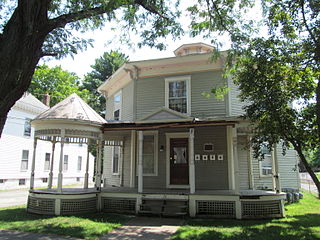
The Octagon House is an historic octagonal house located at 28 King Street in Westfield, Massachusetts. It was built sometime between 1858 and 1864 by Joseph Watson, and is the only one of three 19th-century octagon houses built in the city to survive. The house was listed on the National Register of Historic Places in 1982, and included as part of expansion of the Westfield Center Historic District in 2013.

This is a list of properties and districts in the southern municipalities of Puerto Rico that are listed on the National Register of Historic Places. It includes places along the southern coast of the island, and on the south slope of Puerto Rico's Cordillera Central.

This is a list of the National Register of Historic Places listings in Greenville, South Carolina.

The Chamberlin House is a historic house at 44 Pleasant Street in Concord, New Hampshire. Built in 1886, it is a prominent local example of Queen Anne architecture built from mail-order plans, and now serves as the clubhouse of the Concord Women's Club. It was listed on the National Register of Historic Places in 1982.

The Roswell Butler House is a historic house on Upper Main Street in Essex, Vermont. Built about 1822 with later alterations, it is a good local example of Federal period architecture. It was built for Roswell Butler, a prominent local businessman from whom the surrounding Butler's Corner neighborhood takes its name. The house was listed on the National Register of Historic Places in 2001. It is also known as the 1820 Coffee House and the Kilmoyer House on the Essex Vermont town list of historic sites.

The George Angus and Martha Ansil Beebe House is a historic house located in Provo, Utah, United States. It is listed on the National Register of Historic Places.

The Commerce Street Residential Historic District is a historic district in Greenville, Alabama. The district consists of four houses along Commerce Street, constructed between 1846 and 1895. They represent the final and last remaining residential construction on the town's main street.

The Henry Ahrens House is a historic house located at 212 East University Avenue in Champaign, Illinois. The house was built in 1893 for local businessman Henry Ahrens; it still remains in his family. Architect Seely Brown, who ran a well-regarded practice in Champaign, designed the Queen Anne house. The 2+1⁄2-story house has an asymmetrical plan with a multi-component roof that includes both hipped and gabled sections. The gable ends are decorated with patterned wooden shingles, which are also used on a porch gable and the hood of a three-sided bay window. The wraparound front porch is supported by turned columns; brackets with scalloped and half-circle decorations adorn the tops of the columns.

The Wales N. Johnson House is a historic house at 43 Senior Lane in Woodstock, Vermont. Built in 1889-90 by the owner of a local sawmill, it is a high quality example of vernacular Queen Anne architecture. Now serving as the Jackson House Inn, it was listed on the National Register of Historic Places in 1995.

The Martin House is a historic house located at 707 10th Avenue in Fulton, Illinois. The Italianate house was built in 1855, when the style was becoming popular nationally. The house features a hip roof with bracketed eaves, tall windows, and a bay window on the east side, all distinctive Italianate elements. A wraparound front porch, a Queen Anne element, was added circa 1898. A 1908 renovation of the entry hall and dining room added Eastlake elements to the former and gave the latter an Arts and Crafts design.

44 Front Street in Burlington, Vermont is a well-preserved vernacular Queen Anne Revival house. Built about 1860 and significantly altered in 1892, it is representative of two periods of the city's growth in the 19th century. It was listed on the National Register of Historic Places in 2008.
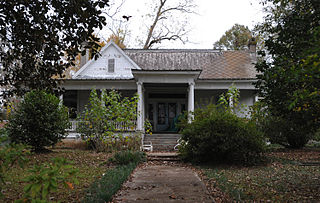
The Dickenson House is a historic residence in Greenville, Alabama. The house is an example of South Alabama vernacular architecture, with a truncated pyramidal roof topped with a flat platform. The house has a wrap-around front porch supported by Ionic columns. A cross-gable dormer with a vent adorns the left side of the façade. The main entry has Eastlake detailing, a transom, and sidelights. The interior features Queen Anne details including horizontally-paneled doors and paneled wainscoting.
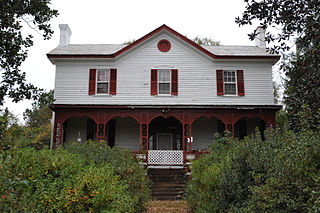
The Evens-McMullan House is a historic residence in Greenville, Alabama. It was built in the late 1860s by Holden Evens, a lumberman who specially selected the timber used in its construction. It was purchased in 1891 by Frank McMullen, a Greenville jeweler.
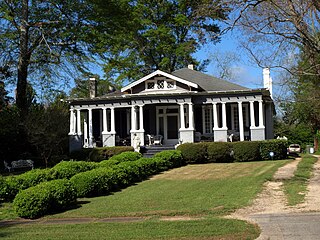
The Fort Dale-College Street Historic District is a historic district in Greenville, Alabama. The district contains Greenville's oldest existing affluent residences, dating to as early as the 1850s. In the initial federal land sale following the Creek War, the area that became northwest Greenville was claimed by William Dunklin. Dunklin sold the claim to William Burnette, who began to parcel the land for sale and to give to family members. Burnette's daughter and son-in-law built a Corinthian-columned Greek Revival home in 1857. A few other pre-Civil War houses remain, and construction continued after the war, including a school building that was later converted into a house. Most of the early residences were large, and built in Greek Revival, Second Empire, and Colonial Revival styles. Beginning in the 20th century, bungalows and cottages on smaller lots began to emerge. One of the later constructions in the district is a Spanish Colonial Revival house, built in 1928.
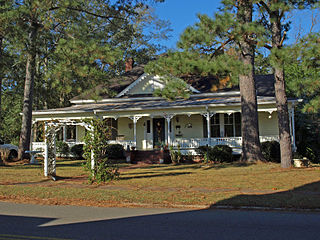
The Graydon House is a historic residence in Greenville, Alabama. The house was built in 1909, and typifies the southern Alabama vernacular house, with a hip roof and wrap-around porch. A gabled dormer is centered on the façade, and the porch has slender columns with elaborate brackets. Decorative woodwork continues inside, including Queen Anne fireplace mantels.

The Yewell House, at 630 Clay St. in Owensboro, Kentucky, was built in 1894. It is Queen Anne in style. It was listed on the National Register of Historic Places in 1986.

The Ihm House is a historic house at 203 N. Garfield Street in Barneveld, Wisconsin. The house was built circa 1891 for property owner Fred Lampop. It has a Queen Anne design featuring a full-length front porch supported by spindled posts, three-sided projecting bays on the front and side, bracketed eaves, and a complex roof with a shingled front-facing gable. The house's interior includes a carved staircase and decorative bullseye patterned woodwork. The house was the most elaborate Queen Anne structure in Barneveld to survive the 1984 tornado which hit the village.






















